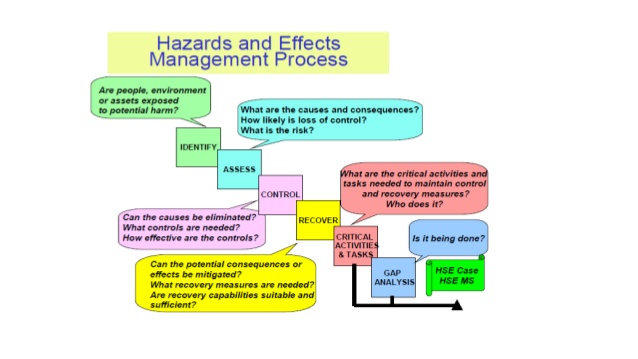HEMP - What is Hazard and Effect Management Process (HEMP)?
WHAT IS HEMP?
HEMP is an acronym for Hazard and Effect Management Process. It is the heart of the Health and safety Management System because it helps in controlling all risk in the workplace and also in managing the impacts failures in control."
HEMP is a risk management process which ensures that Hazards/Risks to workforce, equipments, properties and environments are properly controlled. In cases of failure in controls, it helps manage the impacts of incidents as well.
Often, HEMP is misuse as Risk assessment. Though the two has something in common, they are different. When HEMP is a risk management process, Risk Assessment is a tool that can be used to actualize HEMP.
Risk assessment is in the same category as other risk management tools like Hazid, Hazop, Job safety plan (JSP), Hazard analysis (HAZAN), etc.
Hazard and Effect Management Process (HEMP) has 4 elements:
- Hazard identification
- Risk assessment
- Risk control
- Recovery measures
HAZARD IDENTIFICATION
The starting point for HEMP is in identifying the hazards and risks to the workforce, equipment, materials, environment, etc. This hazards and risk could also be posed by individuals, materials, equipment and environment.
N/B: What is not identified cannot be controlled.
I know someone will ask me; How do I identify these hazards and risks.
There are number of ways hazards and risks can be identified, some of which are:
- Through experience driven judgement: What has been seen, heard and felt over the years while disposing different responsibilities at work is a very strong tool in hazards and risks identification. With this experience, it is easy to spot out hazardous situations, equipment, materials, environments, etc.
- Use of checklist: Some tasks on site have already structured safety checklist to guide on its safe completion. These checklists have been designed by seasoned and experienced professionals. These checklists will guide less experienced employees to pick hazards and risks which they wouldn’t have known on their own.
- Reference to regulations, code and standards: There are regulatory bodies that has given minimum requirements for some task; also, there are documents guiding some tasks. Some of these bodies include: OSHA, HSE-Executives. Some guiding documents include, Factory acts, COSHH, MSDS, etc. These will guide on identifying hazards involved in a task.
This hazard and risk identification should cover all the Activities (Routine and Non-routine activities), Equipment, Products, Services, Lifecycle of assets, Activities of contactor, subcontractor, suppliers, etc.
RISK ASSESSMENT
The next element of HEMP is assessing the identified hazards and risks. At this point, the likelihood that the hazards could result to an accident and the consequence of its occurrence is taken into consideration. This will help in risk rating and prioritizing. The tool for carrying out this is the risk assessment which can be done either qualitatively or quantitatively. From the result of the risk assessment, priority can be set as to the chain of events to control the risks identified.
RISK CONTROL
Risk controls should include prevention, mitigation and recovery measures. There are different types of control plan. They include:
- Elimination of hazards/risks
- Substitution measure: This is where hazardous equipment or material could be substituted for less hazardous ones.
- Engineering controls: Here safety is put into consideration in the design of equipment and tools for safety reasons. Example of this is installing noise protector in noisy machinery, installing guards on machinery, etc.
- Administrative controls: This involves changing of job pattern to reduce exposure when none of the control measures stated above are not feasible.
- PPE: This is always considered as the last line of defense. When all the control fails, the use of PPE is the last line of defense.
All the control measures will be dependent on the result of risk assessment for the different hazards and risks identified.
N/B: The cost of controlling hazards/risk should not out-play the consequence of the hazard when converted to monetary value.
RECOVERY MEASURES
The aim of HEMP is to prevent the release of hazard. In situations when all controls fail, there has to be a plan in place to mitigate the effect of the hazard released. This plan should reduce lost and also enhance speedy return to normal operation.
The main recovery plans are always captured in the site emergency plan. It could be fire emergency plan, Rescuing a worker(s) from confine space or from suspension after falling from height, Emergency shutdown, Alarms, Contingency plans, etc.
The recovery plan should cover all the activities (Routine and Non-routine activities), Equipment, Products, Services, Lifecycle of assets, Activity of contactor, subcontractor, suppliers, etc.
For effective recovery, it is important that each recovery measures be accompanied by a formal documentation.
Responsibilities should be assigned to individuals for recovery action, drills and simulations should be conducted to ascertain the preparedness for emergency, relevant bodies which could help in the situation should be included in the plan, and they should be a memorandum of understanding between both parties.
Hello Guys 🙏, You Gotta Comment(Good, bad etc.) now Please.. 👇🏻
it takes just a couple of seconds to comment for the Information you got in a jiffy. It motivates us to write & share more....Must Comment 👇🏻 🙏


Comments
Post a Comment